Strategic Management Analysis and Financial Report: Liverpool FC
VerifiedAdded on 2021/11/16
|19
|3998
|39
Report
AI Summary
This report presents a comprehensive strategic management analysis of Liverpool Football Club (Liverpool FC). It begins with an executive summary outlining the club's position within the global football industry, emphasizing its strengths, weaknesses, opportunities, and threats. The report includes an internal analysis of Liverpool FC, examining its strengths (brand prominence, marketing) and weaknesses (historical setbacks, competitive challenges). A financial analysis explores the club's economic performance, revenue growth, and comparison with competitors like Manchester City and Manchester United. A macro environment analysis utilizes the PESTEL framework to assess political, economic, social, technological, environmental, and legal factors influencing the football industry and Liverpool FC. The report also considers stakeholder approaches and utilizes a TOWS matrix to formulate strategic recommendations. Finally, it concludes with a summary of findings and key insights into Liverpool FC's strategic positioning and future prospects within the dynamic landscape of professional football. The report uses data and information from various sources to support its claims and analysis.
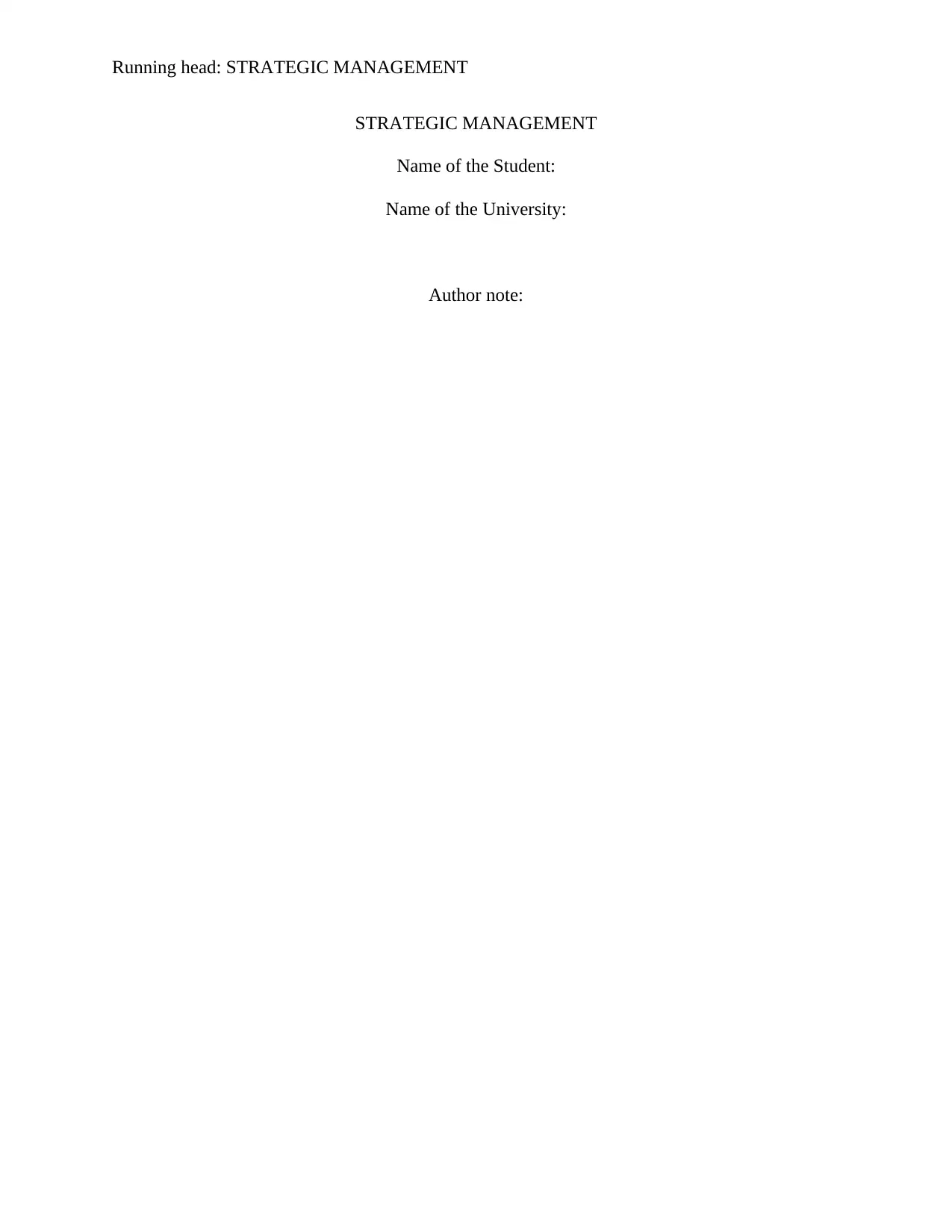
Running head: STRATEGIC MANAGEMENT
STRATEGIC MANAGEMENT
Name of the Student:
Name of the University:
Author note:
STRATEGIC MANAGEMENT
Name of the Student:
Name of the University:
Author note:
Paraphrase This Document
Need a fresh take? Get an instant paraphrase of this document with our AI Paraphraser
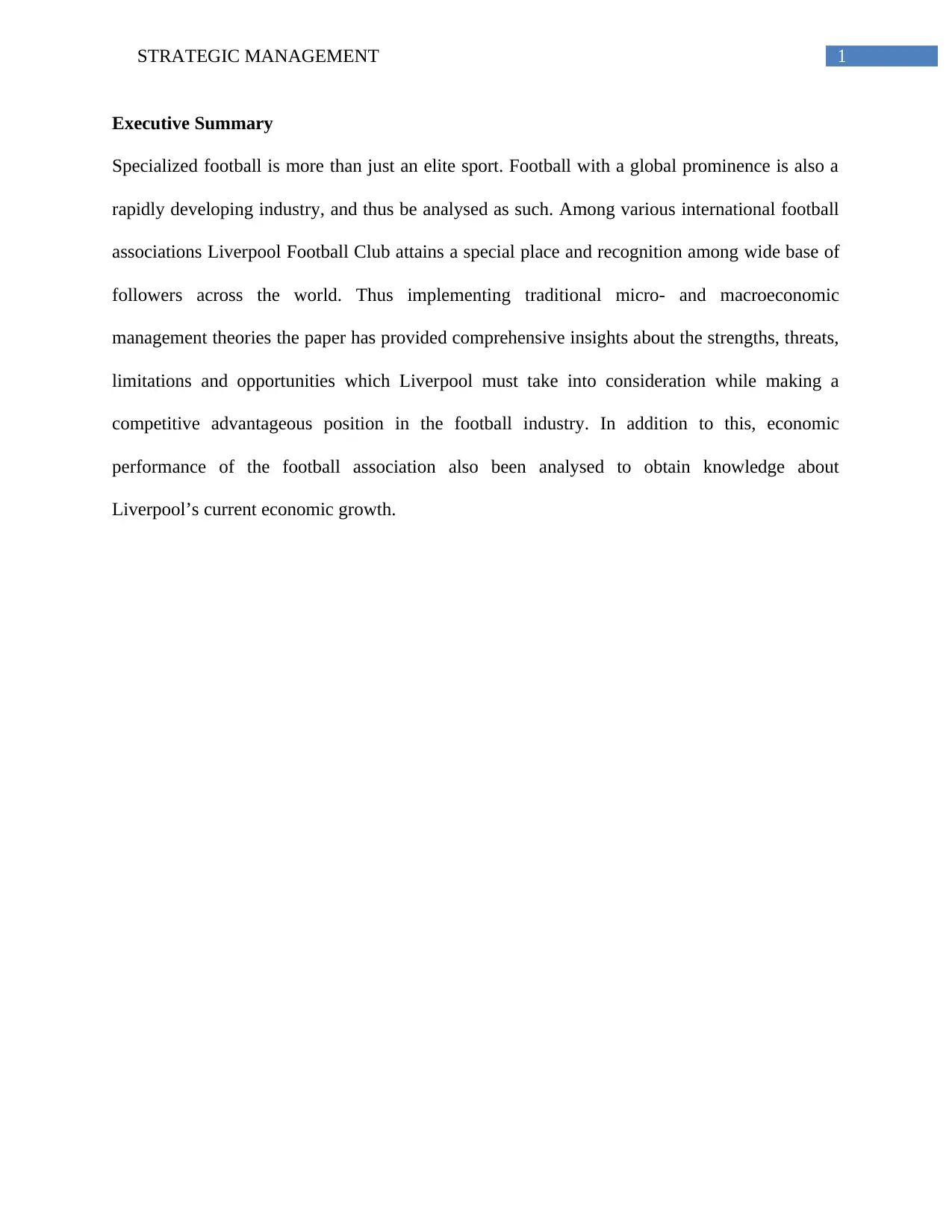
1STRATEGIC MANAGEMENT
Executive Summary
Specialized football is more than just an elite sport. Football with a global prominence is also a
rapidly developing industry, and thus be analysed as such. Among various international football
associations Liverpool Football Club attains a special place and recognition among wide base of
followers across the world. Thus implementing traditional micro- and macroeconomic
management theories the paper has provided comprehensive insights about the strengths, threats,
limitations and opportunities which Liverpool must take into consideration while making a
competitive advantageous position in the football industry. In addition to this, economic
performance of the football association also been analysed to obtain knowledge about
Liverpool’s current economic growth.
Executive Summary
Specialized football is more than just an elite sport. Football with a global prominence is also a
rapidly developing industry, and thus be analysed as such. Among various international football
associations Liverpool Football Club attains a special place and recognition among wide base of
followers across the world. Thus implementing traditional micro- and macroeconomic
management theories the paper has provided comprehensive insights about the strengths, threats,
limitations and opportunities which Liverpool must take into consideration while making a
competitive advantageous position in the football industry. In addition to this, economic
performance of the football association also been analysed to obtain knowledge about
Liverpool’s current economic growth.
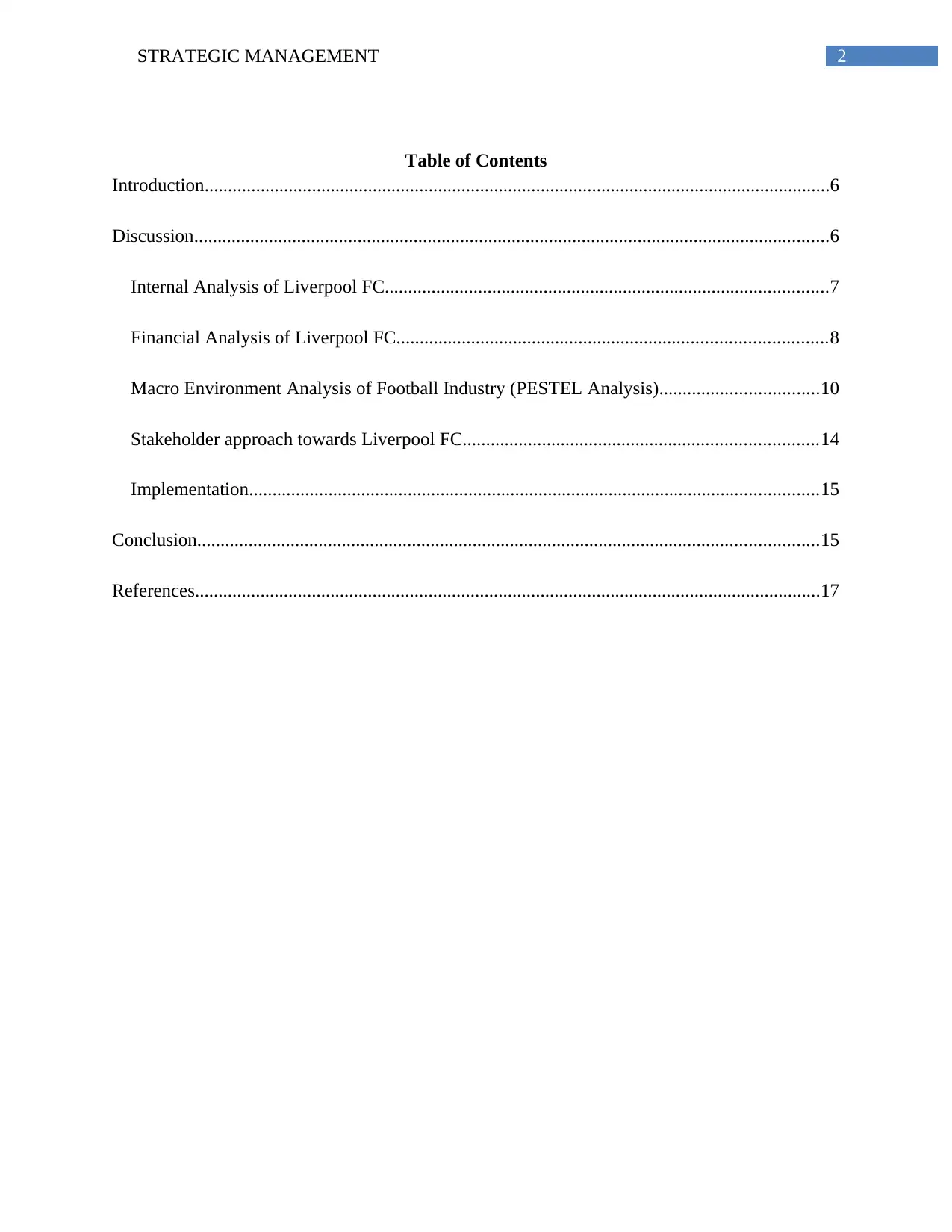
2STRATEGIC MANAGEMENT
Table of Contents
Introduction......................................................................................................................................6
Discussion........................................................................................................................................6
Internal Analysis of Liverpool FC...............................................................................................7
Financial Analysis of Liverpool FC............................................................................................8
Macro Environment Analysis of Football Industry (PESTEL Analysis)..................................10
Stakeholder approach towards Liverpool FC............................................................................14
Implementation..........................................................................................................................15
Conclusion.....................................................................................................................................15
References......................................................................................................................................17
Table of Contents
Introduction......................................................................................................................................6
Discussion........................................................................................................................................6
Internal Analysis of Liverpool FC...............................................................................................7
Financial Analysis of Liverpool FC............................................................................................8
Macro Environment Analysis of Football Industry (PESTEL Analysis)..................................10
Stakeholder approach towards Liverpool FC............................................................................14
Implementation..........................................................................................................................15
Conclusion.....................................................................................................................................15
References......................................................................................................................................17
⊘ This is a preview!⊘
Do you want full access?
Subscribe today to unlock all pages.

Trusted by 1+ million students worldwide
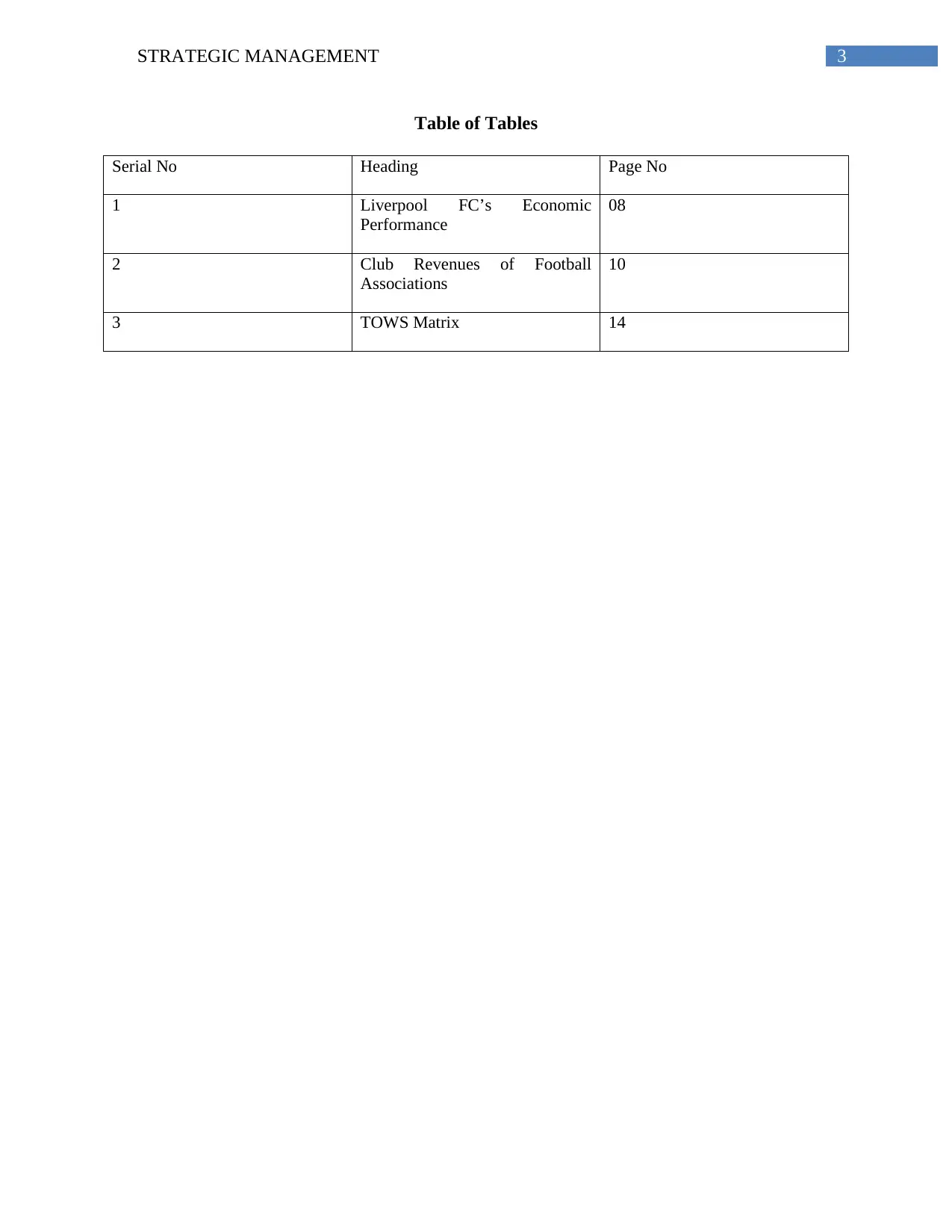
3STRATEGIC MANAGEMENT
Table of Tables
Serial No Heading Page No
1 Liverpool FC’s Economic
Performance
08
2 Club Revenues of Football
Associations
10
3 TOWS Matrix 14
Table of Tables
Serial No Heading Page No
1 Liverpool FC’s Economic
Performance
08
2 Club Revenues of Football
Associations
10
3 TOWS Matrix 14
Paraphrase This Document
Need a fresh take? Get an instant paraphrase of this document with our AI Paraphraser
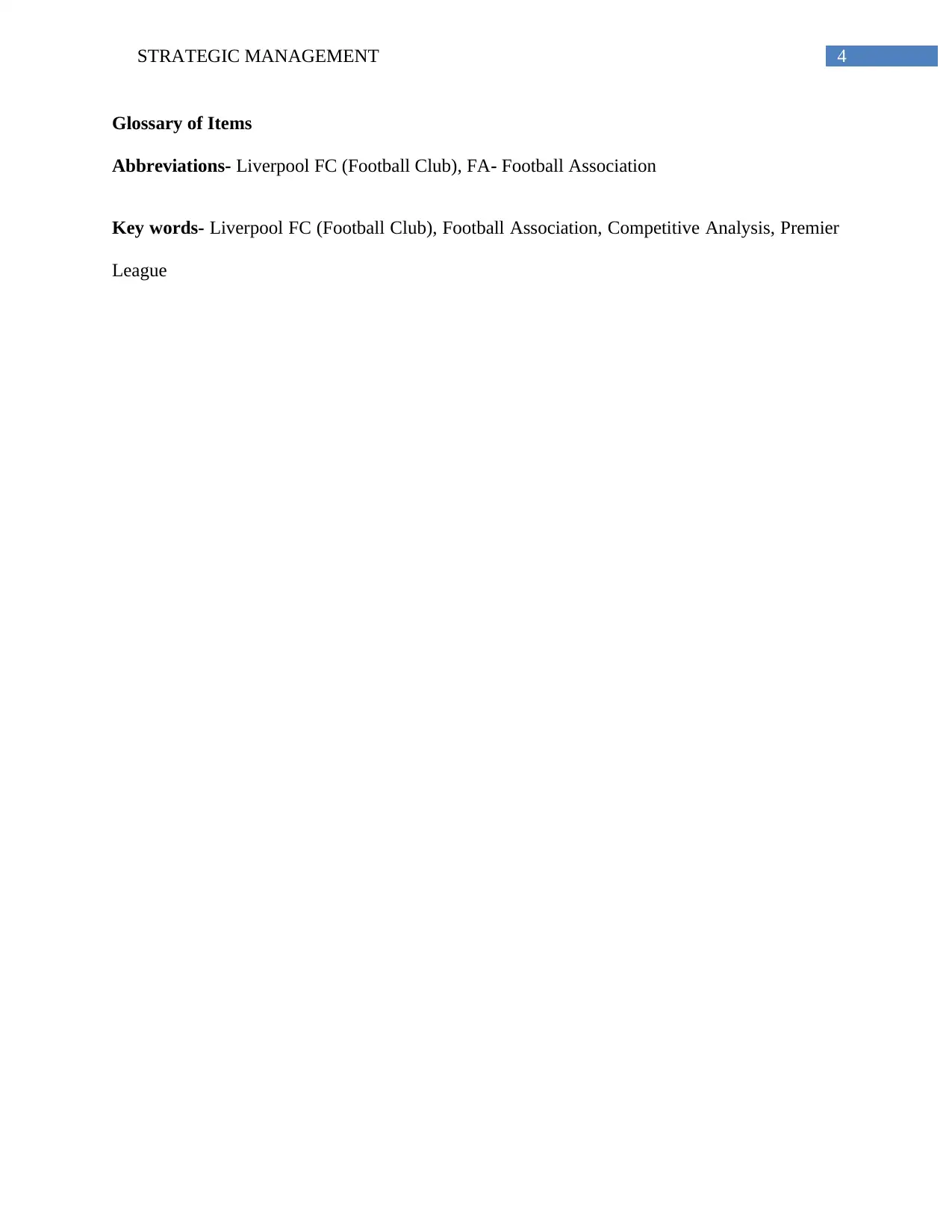
4STRATEGIC MANAGEMENT
Glossary of Items
Abbreviations- Liverpool FC (Football Club), FA- Football Association
Key words- Liverpool FC (Football Club), Football Association, Competitive Analysis, Premier
League
Glossary of Items
Abbreviations- Liverpool FC (Football Club), FA- Football Association
Key words- Liverpool FC (Football Club), Football Association, Competitive Analysis, Premier
League
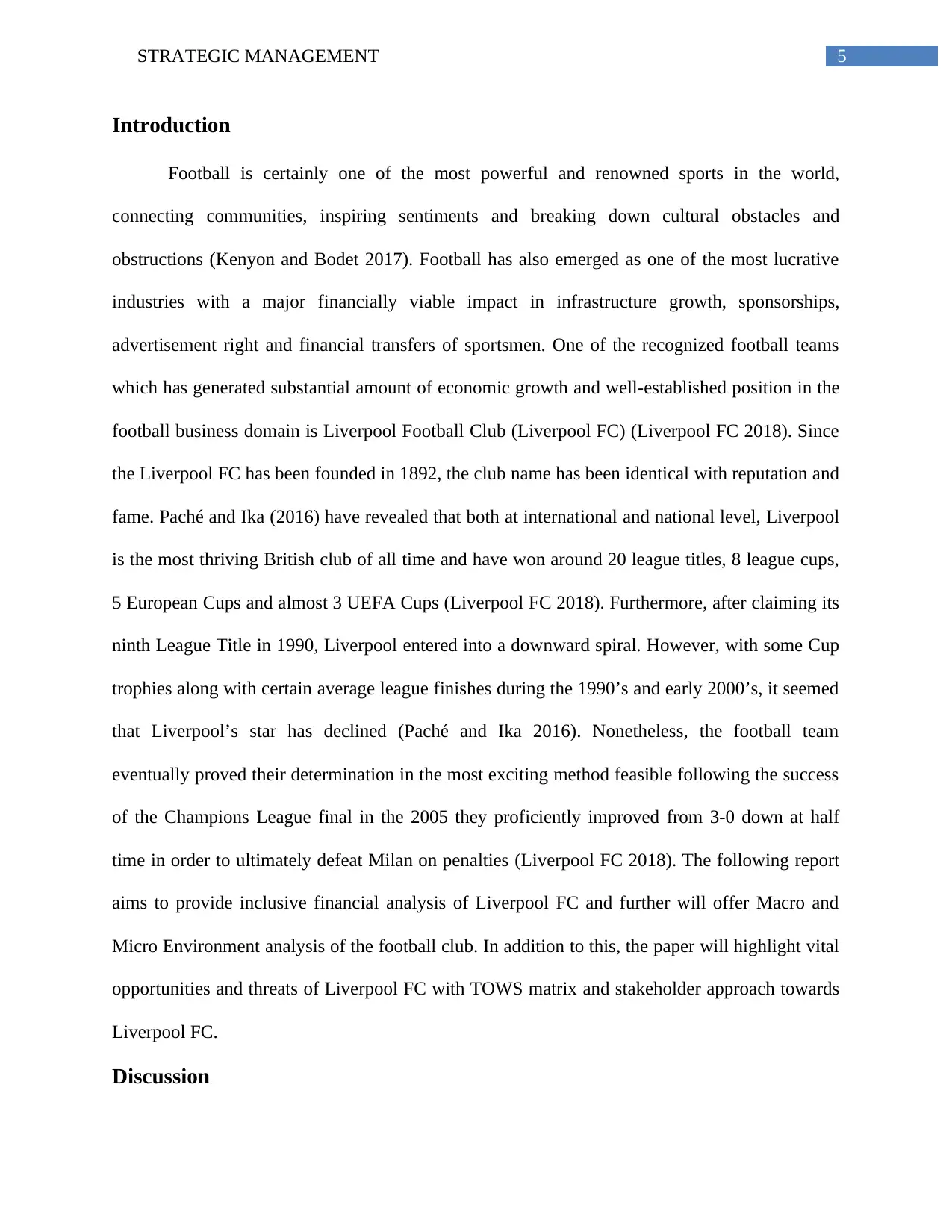
5STRATEGIC MANAGEMENT
Introduction
Football is certainly one of the most powerful and renowned sports in the world,
connecting communities, inspiring sentiments and breaking down cultural obstacles and
obstructions (Kenyon and Bodet 2017). Football has also emerged as one of the most lucrative
industries with a major financially viable impact in infrastructure growth, sponsorships,
advertisement right and financial transfers of sportsmen. One of the recognized football teams
which has generated substantial amount of economic growth and well-established position in the
football business domain is Liverpool Football Club (Liverpool FC) (Liverpool FC 2018). Since
the Liverpool FC has been founded in 1892, the club name has been identical with reputation and
fame. Paché and Ika (2016) have revealed that both at international and national level, Liverpool
is the most thriving British club of all time and have won around 20 league titles, 8 league cups,
5 European Cups and almost 3 UEFA Cups (Liverpool FC 2018). Furthermore, after claiming its
ninth League Title in 1990, Liverpool entered into a downward spiral. However, with some Cup
trophies along with certain average league finishes during the 1990’s and early 2000’s, it seemed
that Liverpool’s star has declined (Paché and Ika 2016). Nonetheless, the football team
eventually proved their determination in the most exciting method feasible following the success
of the Champions League final in the 2005 they proficiently improved from 3-0 down at half
time in order to ultimately defeat Milan on penalties (Liverpool FC 2018). The following report
aims to provide inclusive financial analysis of Liverpool FC and further will offer Macro and
Micro Environment analysis of the football club. In addition to this, the paper will highlight vital
opportunities and threats of Liverpool FC with TOWS matrix and stakeholder approach towards
Liverpool FC.
Discussion
Introduction
Football is certainly one of the most powerful and renowned sports in the world,
connecting communities, inspiring sentiments and breaking down cultural obstacles and
obstructions (Kenyon and Bodet 2017). Football has also emerged as one of the most lucrative
industries with a major financially viable impact in infrastructure growth, sponsorships,
advertisement right and financial transfers of sportsmen. One of the recognized football teams
which has generated substantial amount of economic growth and well-established position in the
football business domain is Liverpool Football Club (Liverpool FC) (Liverpool FC 2018). Since
the Liverpool FC has been founded in 1892, the club name has been identical with reputation and
fame. Paché and Ika (2016) have revealed that both at international and national level, Liverpool
is the most thriving British club of all time and have won around 20 league titles, 8 league cups,
5 European Cups and almost 3 UEFA Cups (Liverpool FC 2018). Furthermore, after claiming its
ninth League Title in 1990, Liverpool entered into a downward spiral. However, with some Cup
trophies along with certain average league finishes during the 1990’s and early 2000’s, it seemed
that Liverpool’s star has declined (Paché and Ika 2016). Nonetheless, the football team
eventually proved their determination in the most exciting method feasible following the success
of the Champions League final in the 2005 they proficiently improved from 3-0 down at half
time in order to ultimately defeat Milan on penalties (Liverpool FC 2018). The following report
aims to provide inclusive financial analysis of Liverpool FC and further will offer Macro and
Micro Environment analysis of the football club. In addition to this, the paper will highlight vital
opportunities and threats of Liverpool FC with TOWS matrix and stakeholder approach towards
Liverpool FC.
Discussion
⊘ This is a preview!⊘
Do you want full access?
Subscribe today to unlock all pages.

Trusted by 1+ million students worldwide
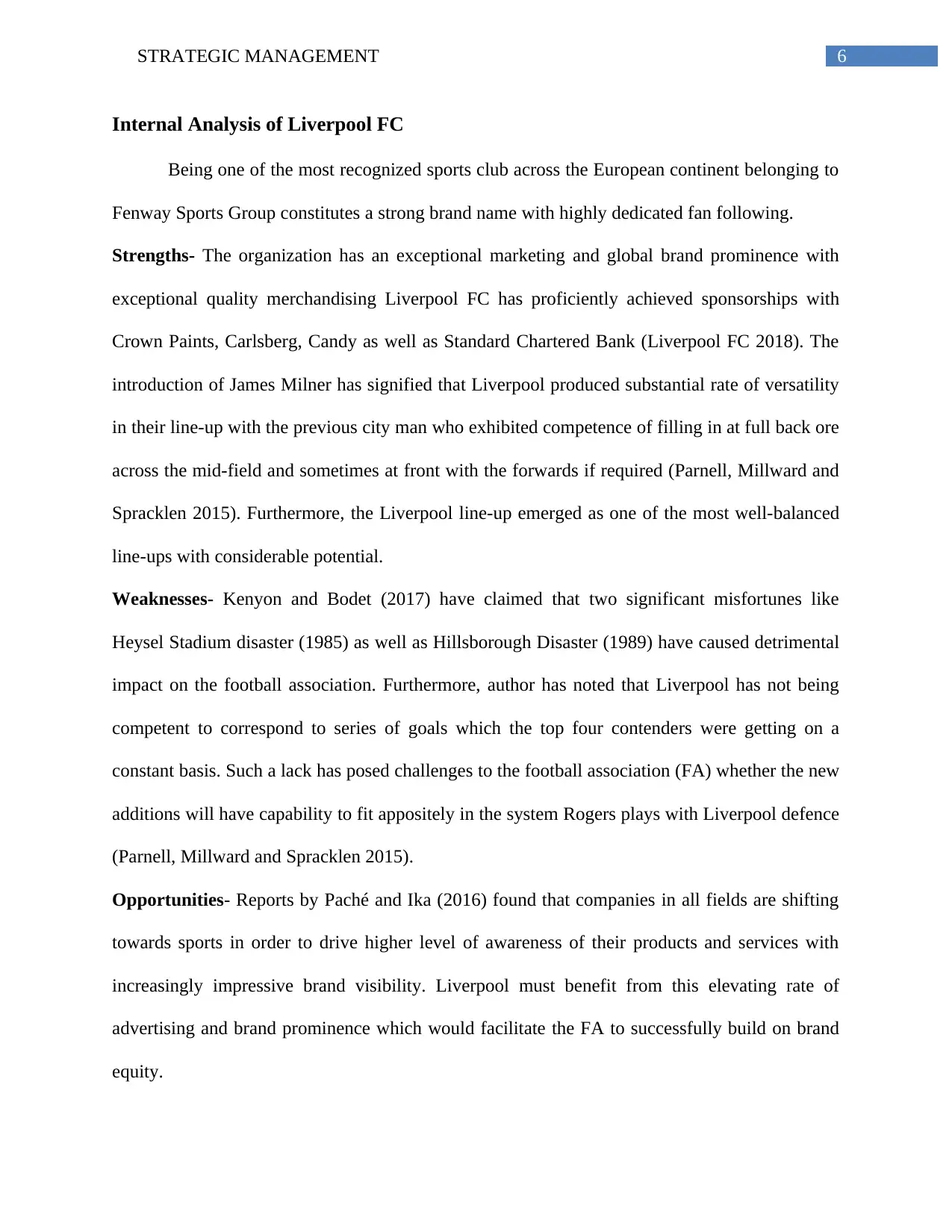
6STRATEGIC MANAGEMENT
Internal Analysis of Liverpool FC
Being one of the most recognized sports club across the European continent belonging to
Fenway Sports Group constitutes a strong brand name with highly dedicated fan following.
Strengths- The organization has an exceptional marketing and global brand prominence with
exceptional quality merchandising Liverpool FC has proficiently achieved sponsorships with
Crown Paints, Carlsberg, Candy as well as Standard Chartered Bank (Liverpool FC 2018). The
introduction of James Milner has signified that Liverpool produced substantial rate of versatility
in their line-up with the previous city man who exhibited competence of filling in at full back ore
across the mid-field and sometimes at front with the forwards if required (Parnell, Millward and
Spracklen 2015). Furthermore, the Liverpool line-up emerged as one of the most well-balanced
line-ups with considerable potential.
Weaknesses- Kenyon and Bodet (2017) have claimed that two significant misfortunes like
Heysel Stadium disaster (1985) as well as Hillsborough Disaster (1989) have caused detrimental
impact on the football association. Furthermore, author has noted that Liverpool has not being
competent to correspond to series of goals which the top four contenders were getting on a
constant basis. Such a lack has posed challenges to the football association (FA) whether the new
additions will have capability to fit appositely in the system Rogers plays with Liverpool defence
(Parnell, Millward and Spracklen 2015).
Opportunities- Reports by Paché and Ika (2016) found that companies in all fields are shifting
towards sports in order to drive higher level of awareness of their products and services with
increasingly impressive brand visibility. Liverpool must benefit from this elevating rate of
advertising and brand prominence which would facilitate the FA to successfully build on brand
equity.
Internal Analysis of Liverpool FC
Being one of the most recognized sports club across the European continent belonging to
Fenway Sports Group constitutes a strong brand name with highly dedicated fan following.
Strengths- The organization has an exceptional marketing and global brand prominence with
exceptional quality merchandising Liverpool FC has proficiently achieved sponsorships with
Crown Paints, Carlsberg, Candy as well as Standard Chartered Bank (Liverpool FC 2018). The
introduction of James Milner has signified that Liverpool produced substantial rate of versatility
in their line-up with the previous city man who exhibited competence of filling in at full back ore
across the mid-field and sometimes at front with the forwards if required (Parnell, Millward and
Spracklen 2015). Furthermore, the Liverpool line-up emerged as one of the most well-balanced
line-ups with considerable potential.
Weaknesses- Kenyon and Bodet (2017) have claimed that two significant misfortunes like
Heysel Stadium disaster (1985) as well as Hillsborough Disaster (1989) have caused detrimental
impact on the football association. Furthermore, author has noted that Liverpool has not being
competent to correspond to series of goals which the top four contenders were getting on a
constant basis. Such a lack has posed challenges to the football association (FA) whether the new
additions will have capability to fit appositely in the system Rogers plays with Liverpool defence
(Parnell, Millward and Spracklen 2015).
Opportunities- Reports by Paché and Ika (2016) found that companies in all fields are shifting
towards sports in order to drive higher level of awareness of their products and services with
increasingly impressive brand visibility. Liverpool must benefit from this elevating rate of
advertising and brand prominence which would facilitate the FA to successfully build on brand
equity.
Paraphrase This Document
Need a fresh take? Get an instant paraphrase of this document with our AI Paraphraser
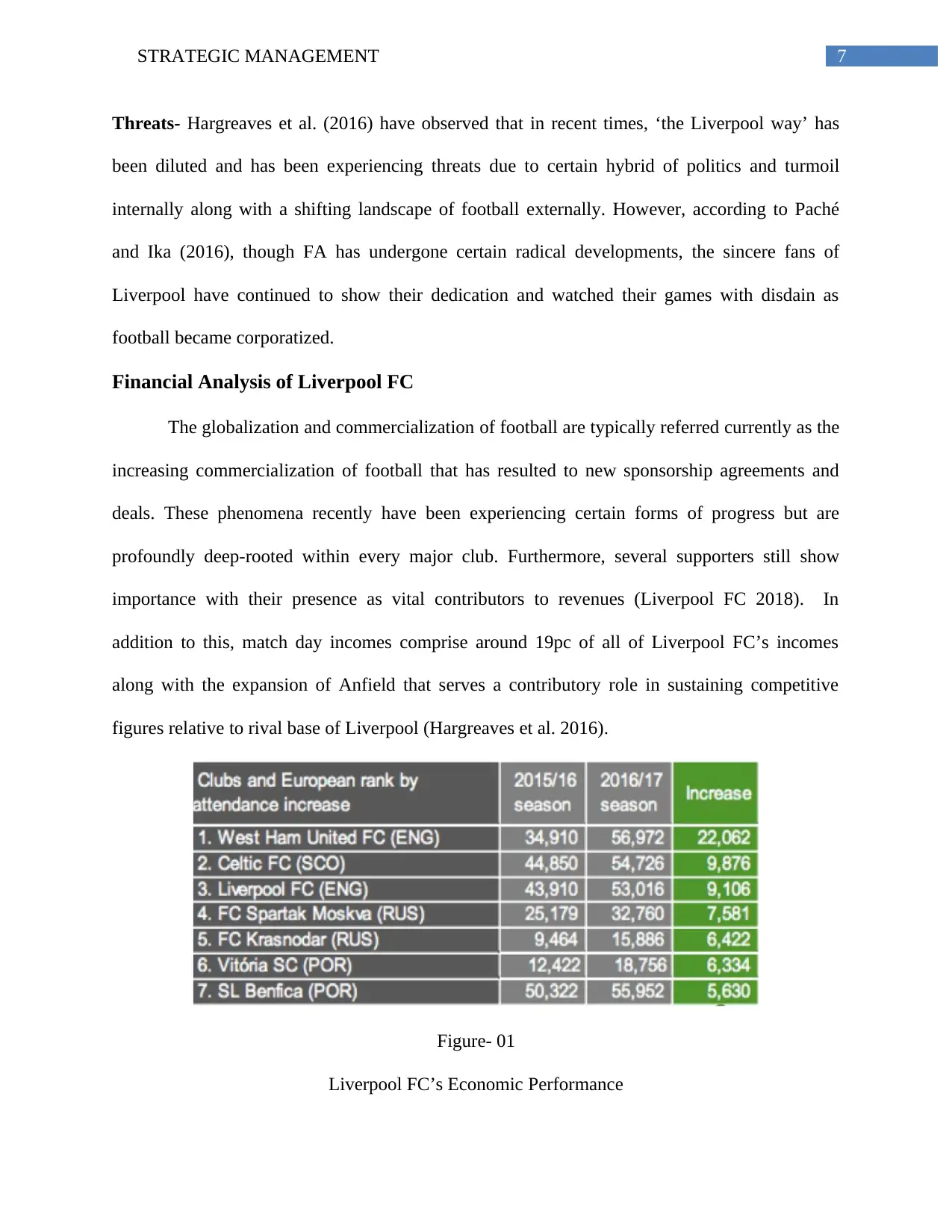
7STRATEGIC MANAGEMENT
Threats- Hargreaves et al. (2016) have observed that in recent times, ‘the Liverpool way’ has
been diluted and has been experiencing threats due to certain hybrid of politics and turmoil
internally along with a shifting landscape of football externally. However, according to Paché
and Ika (2016), though FA has undergone certain radical developments, the sincere fans of
Liverpool have continued to show their dedication and watched their games with disdain as
football became corporatized.
Financial Analysis of Liverpool FC
The globalization and commercialization of football are typically referred currently as the
increasing commercialization of football that has resulted to new sponsorship agreements and
deals. These phenomena recently have been experiencing certain forms of progress but are
profoundly deep-rooted within every major club. Furthermore, several supporters still show
importance with their presence as vital contributors to revenues (Liverpool FC 2018). In
addition to this, match day incomes comprise around 19pc of all of Liverpool FC’s incomes
along with the expansion of Anfield that serves a contributory role in sustaining competitive
figures relative to rival base of Liverpool (Hargreaves et al. 2016).
Figure- 01
Liverpool FC’s Economic Performance
Threats- Hargreaves et al. (2016) have observed that in recent times, ‘the Liverpool way’ has
been diluted and has been experiencing threats due to certain hybrid of politics and turmoil
internally along with a shifting landscape of football externally. However, according to Paché
and Ika (2016), though FA has undergone certain radical developments, the sincere fans of
Liverpool have continued to show their dedication and watched their games with disdain as
football became corporatized.
Financial Analysis of Liverpool FC
The globalization and commercialization of football are typically referred currently as the
increasing commercialization of football that has resulted to new sponsorship agreements and
deals. These phenomena recently have been experiencing certain forms of progress but are
profoundly deep-rooted within every major club. Furthermore, several supporters still show
importance with their presence as vital contributors to revenues (Liverpool FC 2018). In
addition to this, match day incomes comprise around 19pc of all of Liverpool FC’s incomes
along with the expansion of Anfield that serves a contributory role in sustaining competitive
figures relative to rival base of Liverpool (Hargreaves et al. 2016).
Figure- 01
Liverpool FC’s Economic Performance
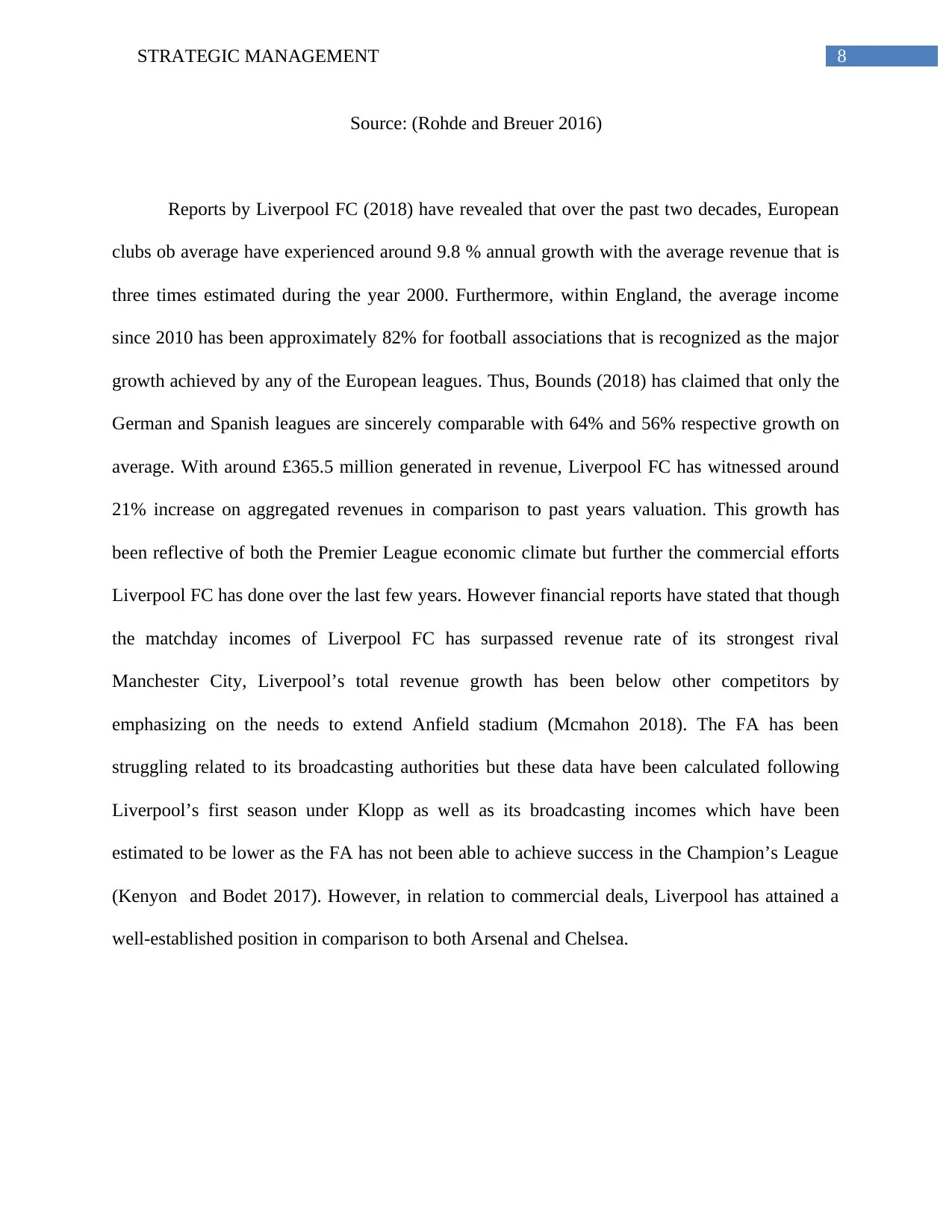
8STRATEGIC MANAGEMENT
Source: (Rohde and Breuer 2016)
Reports by Liverpool FC (2018) have revealed that over the past two decades, European
clubs ob average have experienced around 9.8 % annual growth with the average revenue that is
three times estimated during the year 2000. Furthermore, within England, the average income
since 2010 has been approximately 82% for football associations that is recognized as the major
growth achieved by any of the European leagues. Thus, Bounds (2018) has claimed that only the
German and Spanish leagues are sincerely comparable with 64% and 56% respective growth on
average. With around £365.5 million generated in revenue, Liverpool FC has witnessed around
21% increase on aggregated revenues in comparison to past years valuation. This growth has
been reflective of both the Premier League economic climate but further the commercial efforts
Liverpool FC has done over the last few years. However financial reports have stated that though
the matchday incomes of Liverpool FC has surpassed revenue rate of its strongest rival
Manchester City, Liverpool’s total revenue growth has been below other competitors by
emphasizing on the needs to extend Anfield stadium (Mcmahon 2018). The FA has been
struggling related to its broadcasting authorities but these data have been calculated following
Liverpool’s first season under Klopp as well as its broadcasting incomes which have been
estimated to be lower as the FA has not been able to achieve success in the Champion’s League
(Kenyon and Bodet 2017). However, in relation to commercial deals, Liverpool has attained a
well-established position in comparison to both Arsenal and Chelsea.
Source: (Rohde and Breuer 2016)
Reports by Liverpool FC (2018) have revealed that over the past two decades, European
clubs ob average have experienced around 9.8 % annual growth with the average revenue that is
three times estimated during the year 2000. Furthermore, within England, the average income
since 2010 has been approximately 82% for football associations that is recognized as the major
growth achieved by any of the European leagues. Thus, Bounds (2018) has claimed that only the
German and Spanish leagues are sincerely comparable with 64% and 56% respective growth on
average. With around £365.5 million generated in revenue, Liverpool FC has witnessed around
21% increase on aggregated revenues in comparison to past years valuation. This growth has
been reflective of both the Premier League economic climate but further the commercial efforts
Liverpool FC has done over the last few years. However financial reports have stated that though
the matchday incomes of Liverpool FC has surpassed revenue rate of its strongest rival
Manchester City, Liverpool’s total revenue growth has been below other competitors by
emphasizing on the needs to extend Anfield stadium (Mcmahon 2018). The FA has been
struggling related to its broadcasting authorities but these data have been calculated following
Liverpool’s first season under Klopp as well as its broadcasting incomes which have been
estimated to be lower as the FA has not been able to achieve success in the Champion’s League
(Kenyon and Bodet 2017). However, in relation to commercial deals, Liverpool has attained a
well-established position in comparison to both Arsenal and Chelsea.
⊘ This is a preview!⊘
Do you want full access?
Subscribe today to unlock all pages.

Trusted by 1+ million students worldwide
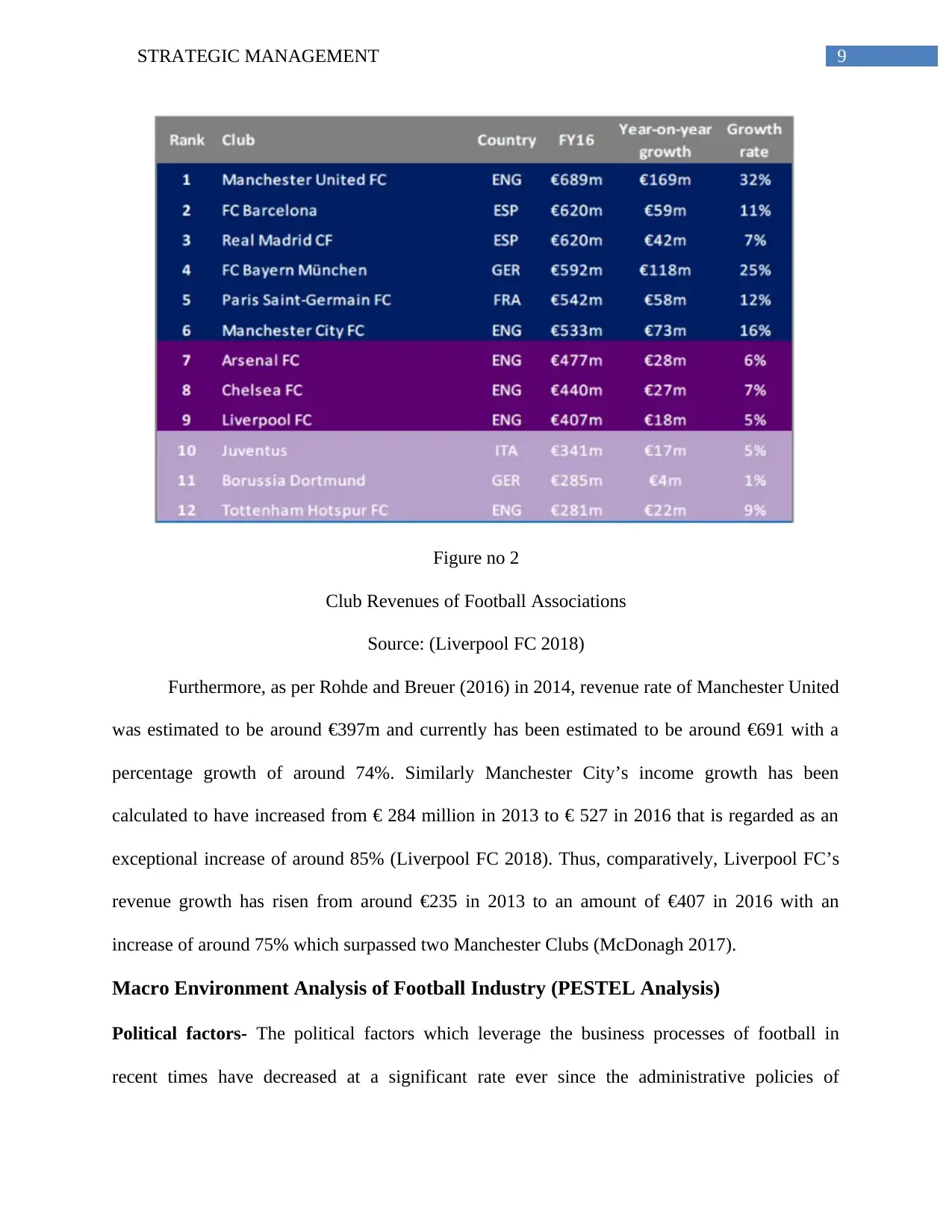
9STRATEGIC MANAGEMENT
Figure no 2
Club Revenues of Football Associations
Source: (Liverpool FC 2018)
Furthermore, as per Rohde and Breuer (2016) in 2014, revenue rate of Manchester United
was estimated to be around €397m and currently has been estimated to be around €691 with a
percentage growth of around 74%. Similarly Manchester City’s income growth has been
calculated to have increased from € 284 million in 2013 to € 527 in 2016 that is regarded as an
exceptional increase of around 85% (Liverpool FC 2018). Thus, comparatively, Liverpool FC’s
revenue growth has risen from around €235 in 2013 to an amount of €407 in 2016 with an
increase of around 75% which surpassed two Manchester Clubs (McDonagh 2017).
Macro Environment Analysis of Football Industry (PESTEL Analysis)
Political factors- The political factors which leverage the business processes of football in
recent times have decreased at a significant rate ever since the administrative policies of
Figure no 2
Club Revenues of Football Associations
Source: (Liverpool FC 2018)
Furthermore, as per Rohde and Breuer (2016) in 2014, revenue rate of Manchester United
was estimated to be around €397m and currently has been estimated to be around €691 with a
percentage growth of around 74%. Similarly Manchester City’s income growth has been
calculated to have increased from € 284 million in 2013 to € 527 in 2016 that is regarded as an
exceptional increase of around 85% (Liverpool FC 2018). Thus, comparatively, Liverpool FC’s
revenue growth has risen from around €235 in 2013 to an amount of €407 in 2016 with an
increase of around 75% which surpassed two Manchester Clubs (McDonagh 2017).
Macro Environment Analysis of Football Industry (PESTEL Analysis)
Political factors- The political factors which leverage the business processes of football in
recent times have decreased at a significant rate ever since the administrative policies of
Paraphrase This Document
Need a fresh take? Get an instant paraphrase of this document with our AI Paraphraser
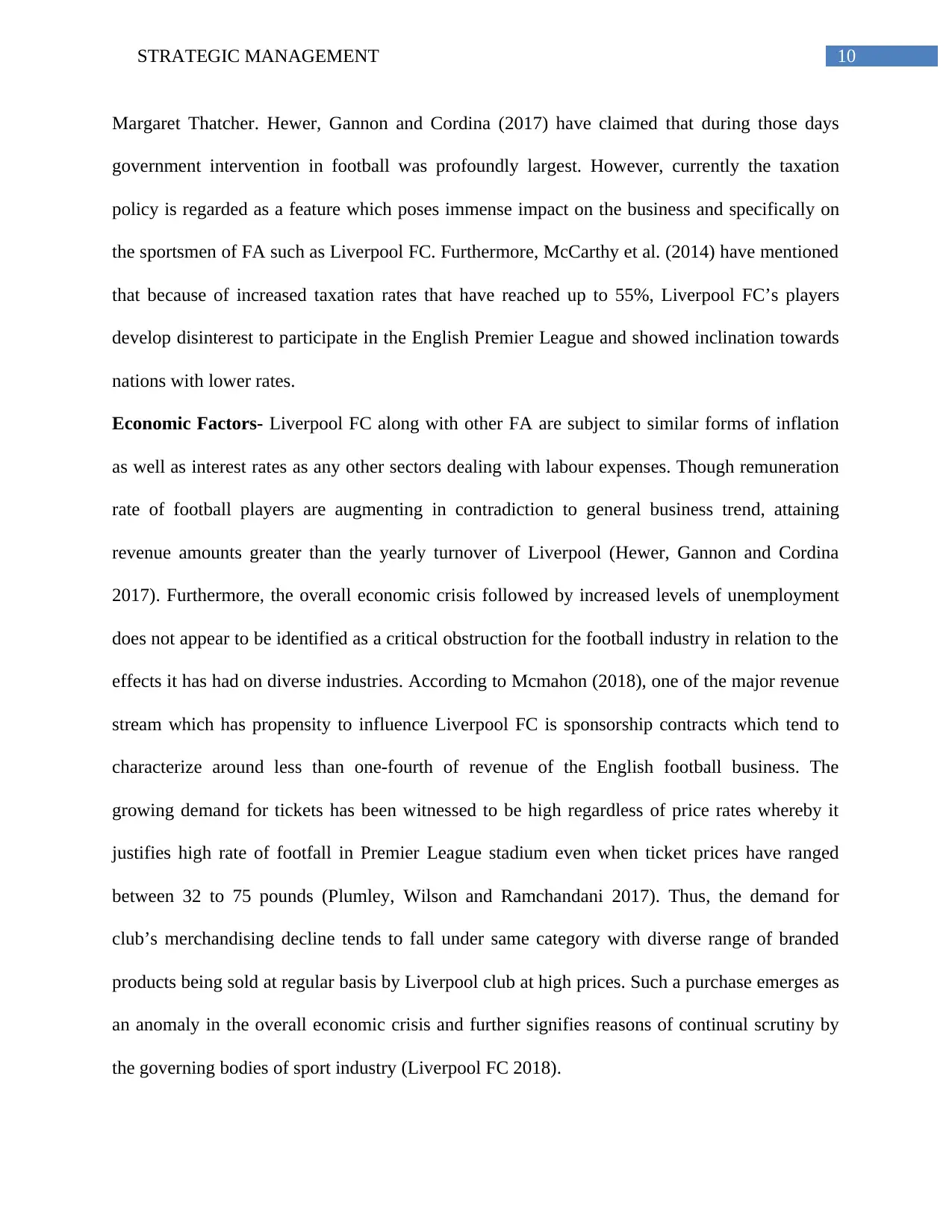
10STRATEGIC MANAGEMENT
Margaret Thatcher. Hewer, Gannon and Cordina (2017) have claimed that during those days
government intervention in football was profoundly largest. However, currently the taxation
policy is regarded as a feature which poses immense impact on the business and specifically on
the sportsmen of FA such as Liverpool FC. Furthermore, McCarthy et al. (2014) have mentioned
that because of increased taxation rates that have reached up to 55%, Liverpool FC’s players
develop disinterest to participate in the English Premier League and showed inclination towards
nations with lower rates.
Economic Factors- Liverpool FC along with other FA are subject to similar forms of inflation
as well as interest rates as any other sectors dealing with labour expenses. Though remuneration
rate of football players are augmenting in contradiction to general business trend, attaining
revenue amounts greater than the yearly turnover of Liverpool (Hewer, Gannon and Cordina
2017). Furthermore, the overall economic crisis followed by increased levels of unemployment
does not appear to be identified as a critical obstruction for the football industry in relation to the
effects it has had on diverse industries. According to Mcmahon (2018), one of the major revenue
stream which has propensity to influence Liverpool FC is sponsorship contracts which tend to
characterize around less than one-fourth of revenue of the English football business. The
growing demand for tickets has been witnessed to be high regardless of price rates whereby it
justifies high rate of footfall in Premier League stadium even when ticket prices have ranged
between 32 to 75 pounds (Plumley, Wilson and Ramchandani 2017). Thus, the demand for
club’s merchandising decline tends to fall under same category with diverse range of branded
products being sold at regular basis by Liverpool club at high prices. Such a purchase emerges as
an anomaly in the overall economic crisis and further signifies reasons of continual scrutiny by
the governing bodies of sport industry (Liverpool FC 2018).
Margaret Thatcher. Hewer, Gannon and Cordina (2017) have claimed that during those days
government intervention in football was profoundly largest. However, currently the taxation
policy is regarded as a feature which poses immense impact on the business and specifically on
the sportsmen of FA such as Liverpool FC. Furthermore, McCarthy et al. (2014) have mentioned
that because of increased taxation rates that have reached up to 55%, Liverpool FC’s players
develop disinterest to participate in the English Premier League and showed inclination towards
nations with lower rates.
Economic Factors- Liverpool FC along with other FA are subject to similar forms of inflation
as well as interest rates as any other sectors dealing with labour expenses. Though remuneration
rate of football players are augmenting in contradiction to general business trend, attaining
revenue amounts greater than the yearly turnover of Liverpool (Hewer, Gannon and Cordina
2017). Furthermore, the overall economic crisis followed by increased levels of unemployment
does not appear to be identified as a critical obstruction for the football industry in relation to the
effects it has had on diverse industries. According to Mcmahon (2018), one of the major revenue
stream which has propensity to influence Liverpool FC is sponsorship contracts which tend to
characterize around less than one-fourth of revenue of the English football business. The
growing demand for tickets has been witnessed to be high regardless of price rates whereby it
justifies high rate of footfall in Premier League stadium even when ticket prices have ranged
between 32 to 75 pounds (Plumley, Wilson and Ramchandani 2017). Thus, the demand for
club’s merchandising decline tends to fall under same category with diverse range of branded
products being sold at regular basis by Liverpool club at high prices. Such a purchase emerges as
an anomaly in the overall economic crisis and further signifies reasons of continual scrutiny by
the governing bodies of sport industry (Liverpool FC 2018).
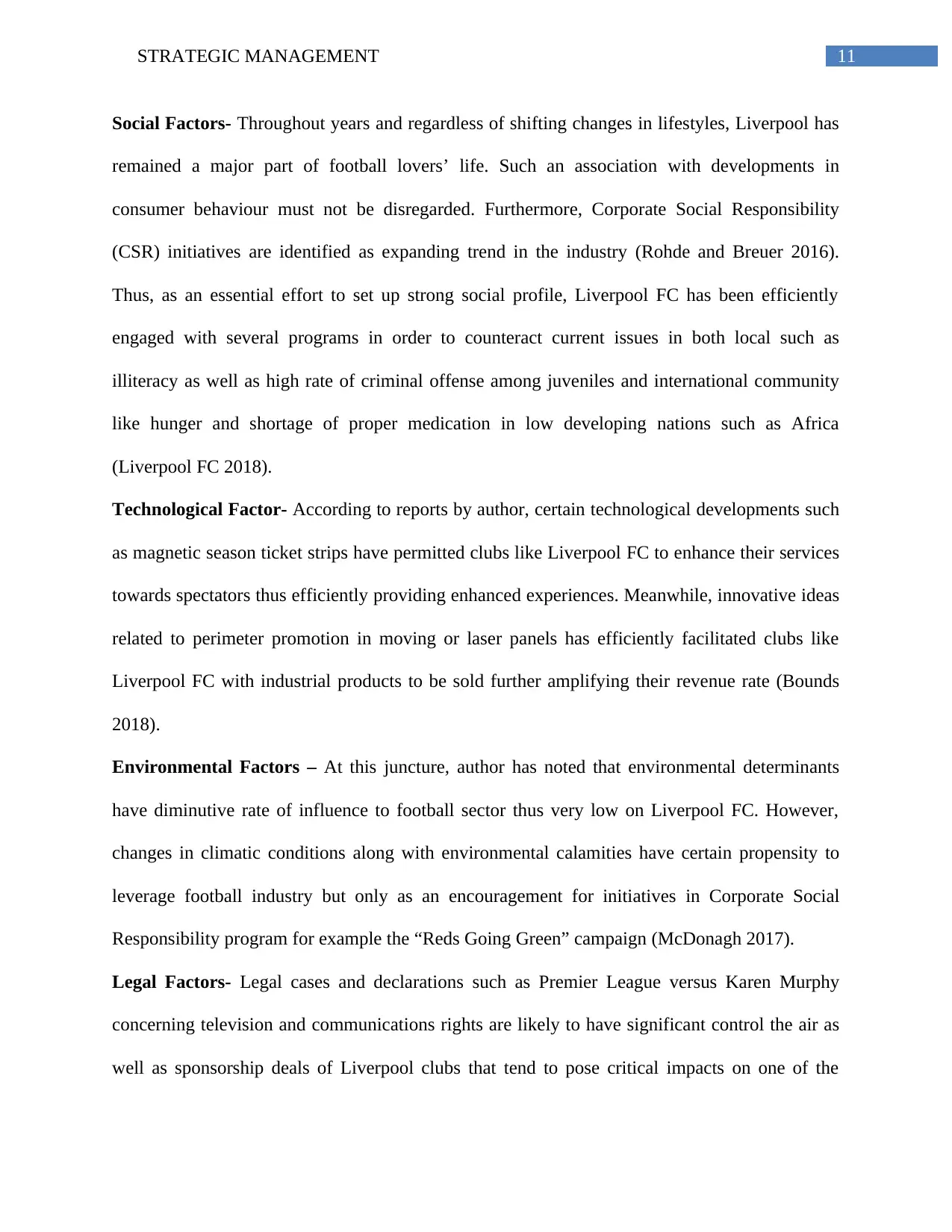
11STRATEGIC MANAGEMENT
Social Factors- Throughout years and regardless of shifting changes in lifestyles, Liverpool has
remained a major part of football lovers’ life. Such an association with developments in
consumer behaviour must not be disregarded. Furthermore, Corporate Social Responsibility
(CSR) initiatives are identified as expanding trend in the industry (Rohde and Breuer 2016).
Thus, as an essential effort to set up strong social profile, Liverpool FC has been efficiently
engaged with several programs in order to counteract current issues in both local such as
illiteracy as well as high rate of criminal offense among juveniles and international community
like hunger and shortage of proper medication in low developing nations such as Africa
(Liverpool FC 2018).
Technological Factor- According to reports by author, certain technological developments such
as magnetic season ticket strips have permitted clubs like Liverpool FC to enhance their services
towards spectators thus efficiently providing enhanced experiences. Meanwhile, innovative ideas
related to perimeter promotion in moving or laser panels has efficiently facilitated clubs like
Liverpool FC with industrial products to be sold further amplifying their revenue rate (Bounds
2018).
Environmental Factors – At this juncture, author has noted that environmental determinants
have diminutive rate of influence to football sector thus very low on Liverpool FC. However,
changes in climatic conditions along with environmental calamities have certain propensity to
leverage football industry but only as an encouragement for initiatives in Corporate Social
Responsibility program for example the “Reds Going Green” campaign (McDonagh 2017).
Legal Factors- Legal cases and declarations such as Premier League versus Karen Murphy
concerning television and communications rights are likely to have significant control the air as
well as sponsorship deals of Liverpool clubs that tend to pose critical impacts on one of the
Social Factors- Throughout years and regardless of shifting changes in lifestyles, Liverpool has
remained a major part of football lovers’ life. Such an association with developments in
consumer behaviour must not be disregarded. Furthermore, Corporate Social Responsibility
(CSR) initiatives are identified as expanding trend in the industry (Rohde and Breuer 2016).
Thus, as an essential effort to set up strong social profile, Liverpool FC has been efficiently
engaged with several programs in order to counteract current issues in both local such as
illiteracy as well as high rate of criminal offense among juveniles and international community
like hunger and shortage of proper medication in low developing nations such as Africa
(Liverpool FC 2018).
Technological Factor- According to reports by author, certain technological developments such
as magnetic season ticket strips have permitted clubs like Liverpool FC to enhance their services
towards spectators thus efficiently providing enhanced experiences. Meanwhile, innovative ideas
related to perimeter promotion in moving or laser panels has efficiently facilitated clubs like
Liverpool FC with industrial products to be sold further amplifying their revenue rate (Bounds
2018).
Environmental Factors – At this juncture, author has noted that environmental determinants
have diminutive rate of influence to football sector thus very low on Liverpool FC. However,
changes in climatic conditions along with environmental calamities have certain propensity to
leverage football industry but only as an encouragement for initiatives in Corporate Social
Responsibility program for example the “Reds Going Green” campaign (McDonagh 2017).
Legal Factors- Legal cases and declarations such as Premier League versus Karen Murphy
concerning television and communications rights are likely to have significant control the air as
well as sponsorship deals of Liverpool clubs that tend to pose critical impacts on one of the
⊘ This is a preview!⊘
Do you want full access?
Subscribe today to unlock all pages.

Trusted by 1+ million students worldwide
1 out of 19
Your All-in-One AI-Powered Toolkit for Academic Success.
+13062052269
info@desklib.com
Available 24*7 on WhatsApp / Email
![[object Object]](/_next/static/media/star-bottom.7253800d.svg)
Unlock your academic potential
Copyright © 2020–2025 A2Z Services. All Rights Reserved. Developed and managed by ZUCOL.

